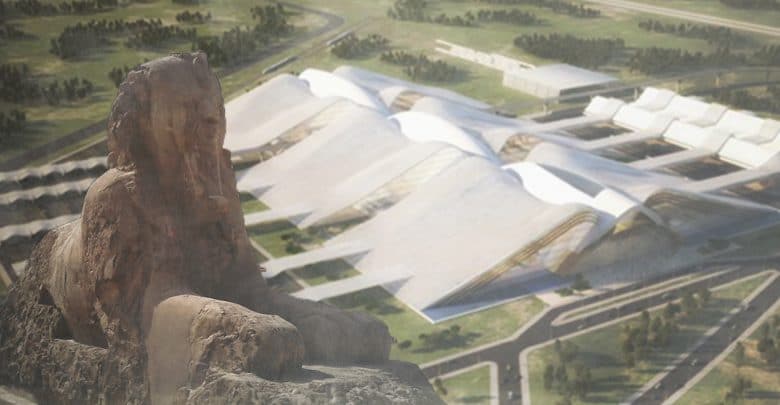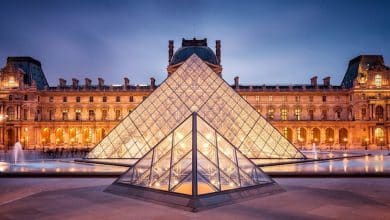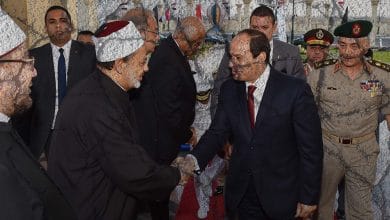
Egypt New Capital Museum: Objectives and Risks
A museum is a revealing mirror that reflects the civilization and history of peoples and countries. Through museums, generations learn about the stages and periods of their country’s history. A museum is also an educational, cultural and recreational institution that serves the community through collecting, preserving, displaying and maintaining the human, natural, and cultural heritage[1]. Archaeological museums are the oldest types of museums over the world, that ensure the continuity of memory and tell the tales, history and civilizations of peoples through artifacts from past civilizations; which strengthens people’s relationship with their history and identity[2].
It may be good to build new archaeological museums in Egypt, but certainly it is better to quickly complete the museums already under construction. However, the best thing ever is to re-open the years-long closed museums, such as the Greco-Roman Museum in Alexandria, whose restoration were suspended eight years ago, and the Royal Vehicles Museum in Bulaq Abul-Ela in downtown Cairo[3]. The government should pay more attention to existing museums and boost tourism, as many museums currently suffer from a lack of visitors, such as the Marsa Matrouh Museum and the Sohag National Museum, which has recently been opened under a major media festival.
In fact, visitors and revenues of Egyptian museums are not at all commensurate with the history of Egypt and its monuments. While the number of archaeological and historical museums in Egypt reached 34 museums in 2018, with 2.845 million visitors and about LE 169.021 million of proceeds[4], the Louvre Museum in Paris – which mainly depends on Egyptian antiquities – hosted 10.2 million visitors in the same year, which means that the number of visitors to all Egyptian museums does not exceed 27% of the number of visitors to France’s Louvre Museum alone[5]. The problem does not lie in the need to build new museums but rather in how to manage and promote the existing museums. The Minister of Antiquities announced on August 28 that there are museums that have been closed for year, adding that the ministry of antiquities cannot build new museums due to the funding problem it has been suffering from[6].
First: The New Capital Museum
Recently, the Ministry of Antiquities, as well as several state officials, announced establishment of a new museum in the administrative capital (under construction)[7]. Major General Ahmed Zaki Abdeen, chairman of the new Administrative Capital for Urban Development (ACUD) company, announced last January that an archaeological museum would be established on an area of 8500 square meters next to the government district in the administrative capital, with two obelisks for King Ramses II decorating its entrance[8], with the statue of King Ramses II, transferred from Mit Rahinah, as the museum’s crown jewel[9].
Dr. Khaled Al-Anani, Minister of Antiquities, said the new museum will highlight the concept of religious tolerance via its Pharaonic, Islamic, Coptic and Jewish artifacts, adding that it will show how Egyptian civilization adopted and respected all religions and civilizations that have passed through Egypt[10]. Dr. Ali Omar, chairman of the Museum Presentation Scenario Committee of Regional Museums, stated that the museum will tell the history of Egypt through different historical eras, including the history behind the Egyptian capitals from prehistoric eras to modern times, starting from Memphis, Thebes and Minya, through Alexandria during the Greek and Roman times, up to Fustat, Fatimid Cairo and Khedive Cairo.[11]
The army to establish the new capital museum:
Despite the fact that there is a sector called “Museum Sector” at the Ministry of Antiquities, which is responsible for building and development of archaeological museums, and despite existence of another sector called “projects sector” that is also responsible for building and development of museums in coordination with the ‘museum sector’; however, the Egyptian Ministry of Antiquities and the Armed Forces’ Almasa Group on Aug. 27 signed a cooperation protocol to establish the new museum in the new capital’s City of Arts and Culture. It was agreed that the Supreme Council of Antiquities will administer and supervise the museum’s antiquities. It will also select the artifacts to be displayed, prepare the design of the showcases and provide full security of the artifacts. The City of Arts and Culture will be responsible for the construction of the museum and the services to be provided, including provision of modern lighting, fire insurance, theft insurance and general cleanliness. In a press statement, Minister of Antiquities Khaled al-Anani said, “The protocol provides the Ministry of Antiquities’ collection of artifacts to the museum of the New Administrative Capital for a period of 10 years, which is renewable. The profits will be shared by the ministry and Almasa Group.” The museum will be open for visitors throughout the weekdays from 9 am to 2 pm, and from 4 pm to 8 pm[12].
Second: Movable Antiquities of the Capital Museum
Officials at the Ministry of Antiquities confirmed that the museum will be lent 1000 pieces of artifacts for 10 years that are renewable[13], and that the pieces will be transferred from museums, stores and various archaeological sites. They also stressed that there is a scientific committee composed of archaeologists and former and current ministers to select those artifacts.[14]
Strange enough, the 1,000 pieces of the new capital’s museum contain antiquities that are immovable in accordance with Egyptian and international antiquities laws. The Ministry of Antiquities announced the transfer of Tutu Tomb from the Diabiya area of Sohag Governorate, relics from the area of Mit Rahinah in Giza, and monuments from the “San El-Hagar” in the Sharqia Governorate to the new capital museum[15]. Other immovable artifacts are illustrated as follows:
1) Transferring Tutu Tomb to the New Capital Museum
The discovery of the Tutu Tomb came by chance after thieves found it during illegal excavations in 2018. The tomb dates to the Ptolemaic period. The Ministry of Antiquities[16] justified the dismantling and relocation of the tomb, saying that it is located in an isolated area that is not easily accessible, lacking a paved road, located on a land that does not belong to the Ministry of Antiquities, and difficult to protect[17]. The ministry considered that the transfer the tomb will protect it from damage and theft, although the Secretary-General of the Supreme Council of Antiquities had announced that the tomb was well secured[18]. However, the Secretary-General of the Supreme Council of Antiquities announced last August that the decision to transfer the Tutu Tomb came after the approval of the Permanent Committee of Egyptian Antiquities, and that a team of archaeologists and restorers from the ministry had conducted a study and made a comprehensive report on the tomb’s status before the transfer[19]!
2) Transferring the relics of Mit Rahinah to the administrative capital
Mit Rahinah, rich in ancient antiquities, is the oldest capital of ancient Egypt, which is called Men Nefer in hieroglyphic, meaning enduring and beautiful port. There is an open museum in Mit Rahinah that is considered one of the most important Egyptian museums, established in 1962, and including a huge statue of King Ramses II. The museum also includes a painting of King Abres, one of the kings of the late era during the era of the 26th Dynasty. The Secretary General of the Supreme Council of Antiquities said that the statue of King Ramses II in Mit Rahinah Museum will be transferred to the administrative capital. A portrait of King Abris, written in hieroglyphics, will also be transferred, although it is connected to the history of the area; being dedicated to the god Ptah of the capital of Memphis[20].
Third: Risks of transferring immovable relics and proposed solutions
Recently, the Ministry of Antiquities has maintained the transfer of immovable relics to other areas, as mentioned above, and issued further decisions to transfer many other immovable monuments:
A) Damages and risks of transferring immovable relics
In addition to violating local and international antiquity laws, the process of transferring immovable antiquities has many risks and likely damages, including:
1- It exposes relics to damage and destruction that is not easy to restore.
2- The decisions to transfer immovable relics are reckless. They should remain in the place where they were discovered as they tell the history of these areas.
3- According to the Egyptian Antiquities Protection Law No. 117 of 1983 and its amendment (No. 91 of 2018), the immovable antiquities, including houses, tombs, irrigation canals, and man-made holes – should remain in place[21].
4- In accordance with international law, and in accordance with article 1 of the 1954 Hague Convention for the Protection of Cultural Property, archaeological and cultural sites constitute a symbol, identity and history of peoples, and any attack on such property is therefore an attack on the dignity and history of peoples[22]. Therefore, it is not permissible to transfer monuments, especially the immovable relics, to other locations.
5- Article VII of the Venice Charter, which Egypt signed in 1964, provides that “A monument is inseparable from the history to which it bears witness and from the setting in which it occurs. The moving of all or part of a monument cannot be allowed except where the safeguarding of that monument demands it or where it is justified by national or international interest of paramount importance.”
6- Officials arguing that the status and condition of a tomb or any immovable relic is a justification for its transfer to any other place, should consider improving the bad conditions suffered by temples and archaeological sites instead.
7- Some experts believe that allowing the transfer of movable and immovable antiquities to museums in new urban sites such as the Museum of the Administrative Capital and the New Alamein Museum is aimed at pleasing authorities at the expense of these monuments.
8- Member of Parliament Nadia Henry filed a request briefing to the Prime Minister and the Minister of Antiquities for the transfer of Tutu Tomb, saying that the transfer and dismantling of the Pharaonic monuments expose them to distortion, threaten the Egyptian ancient history, and deprive future generations of their right to enjoy them[23].
B) Proposed Solutions
1- Archaeological museums should not be established in new and remote urban areas, but they should be located by the archaeological sites and in populated cities to be easily accessible by visitors and researchers; museums are built to be visited by tourists, not to beautify and decorate new cities.
2- There is a need to establish a national museum agency affiliated to the Ministry of Antiquities to include all museums, work for management and development of them, similarly to what happens in most world countries.
3- Attention should be paid to developing existing museums and providing safety and protection to archaeological sites.
4- Egyptian museums should keep pace with the accelerated global changes and developments.
5- Working to establish museums near archaeological sites to preserve the new discoveries in the same site and make this heritage available for visitation by all segments of the public[24].
6- Making sure the newly-discovered monuments are placed on the tourist map and providing promotion programs to attract tourists to them: for example, the ministry should have made use of the discovery of the Tutu Tomb (announced at a conference attended by the Minister of Antiquities and Governor of Sohag and forty foreign ambassadors last April) for promoting tourism and attracting tourists to the area especially that the Tutu Tomb is ranked third in Sohag with respect to importance after “Abydos” and Akhmim[25].
7- Instead of signing protocols with other bodies such as
the army’s Almassa Group, establishing and developing museums should be entrusted
to the Ministry of Antiquities’ concerned departments[26].
Footnotes
[1]Roland Breton, Geography of Civilizations, Translation: Ahmad Khalil, Oweidat Publications, Beirut, Lebanon, 1998.
[2] Abdel-Fattah Mostafa Ghoneima, Museums, Exhibitions and Palaces, Teaching Aids, Dar El Maaref, Alexandria, Egypt 1990
[3] Asharq Al-Awsat, New Egyptian museums in the governorates to highlight the Pharaonic civilization including the administrative capital and the new Alamein, Tanta, Hurghada and Sharm, 14 Dhul Hijjah 1440 AH-15 August 2019
[4] Al Watan, “Statistics”: 2.845 million visitors to historical and archaeological museums in 2018, 18 May 2019
[5] France 24, Louvre tops the throne of world museums by surpassing 10 million visitors in 2018, January 3, 2019
[6] Sada El-Balad, Secret of the genius of the museum of the new administrative capital. A repeated story in Egyptian history, August 28, 2019
[7] The new administrative capital will be built on an area of 170,000 feddans. It is located between Greater Cairo and Suez Canal region near the ring road.
[8] Masrawy, Ministry of Antiquities: Inauguration of the New Capital Museum within weeks, 17 July 2019
[9] Al-Fagr, Learn about the site and the most prominent relics of the museum of the new administrative capital, 27 January 2019
[10] Al-Ahram, Museum of the administrative capital dating the capitals of Egypt through ages, 27 January 2019
[11] Youm7, Inauguration of the new administrative capital museum with 1000 renewable artifacts, 29 August 2019
[12] Al-Bawaba News, Protocol of cooperation to display artifacts in the administrative capital and Matrouh governorate, September 9, 2019
[13] Youm7, Inauguration of the new administrative capital museum with 1000 renewable artifacts, 29 August 2019
[14] Al-Ahram, Museum of the administrative capital dating the capitals of Egypt through ages, 27 January 2019
[15] The New Arab, Relocating a newly discovered archaeological grave to the administrative capital, July 30, 2019
[16] Akhbar al-Youm, Dismantling walls of the Tutu Grave for transfer to the administrative capital museum, 3 August 2019
[17] Al-Shorouq, Ministry of Antiquities: Tutu Grave discovered by thieves. Its contents will be transferred to the New Capital Museum, August 4, 2019
[18] Youm7, Tutu Grave discovered in Sohag as part of the new administrative capital museum screening, July 31, 2019
[19] Akhbar al-Youm, Dismantling walls of the Tutu Grave for transfer to the administrative capital museum, 3 August 2019
[20] Al-Fagr, Learn about “Mit Rahinah” before transferring its relics to the new administrative capital museum, January 23, 2019
[21] Law No. 91 of 2018 amending Law No. 117 of 1983on the Protection of Antiquities, the Official Gazette No. 23bis (a) dated 11/6/2018
[22] Protecting the cultural heritage of peoples to protect human identity, Al-Ansani Magazine, ICRC, No. 47, Winter 2009/2010, pp. 8-11
[23] Al-Jazeera, Save Tutu. Transfer of a Pharaonic grave to the administrative capital infuriates archaeologists, August 6, 2019
[24] Antiquities Museums: Identity, Development and Contemporary Reality, Damascus University Journal, Vol. 30, No. 3, p. 574
[25] The New Arab, Transfer of a newly discovered archaeological grave to the administrative capital, July 30, 2019
[26] The views expressed in this article are entirely those of the author’s and do not necessarily reflect the views of EIPSS.
To Read Text in PDF Format Click here.



